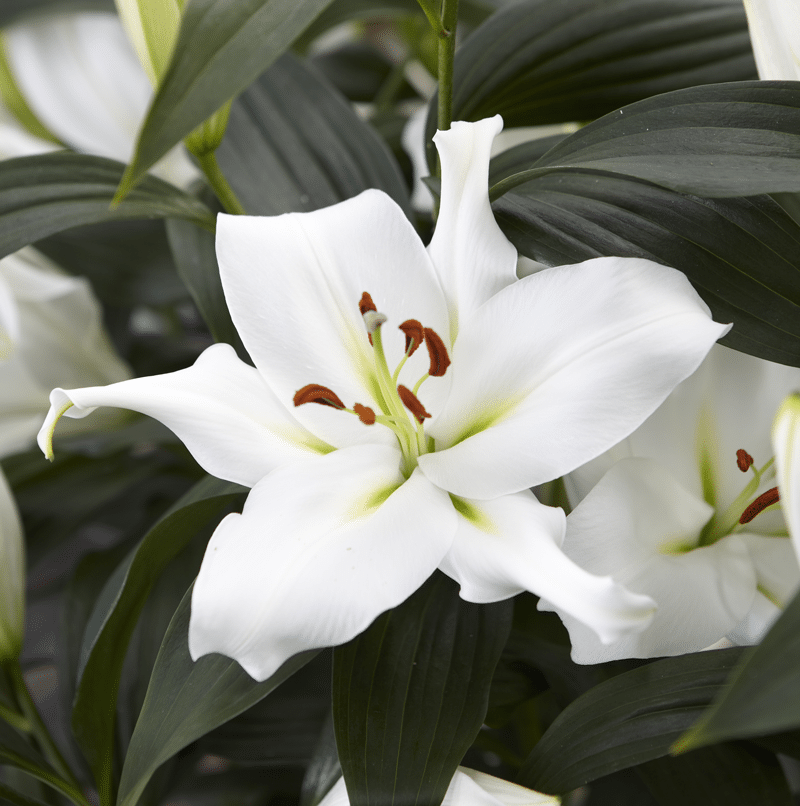Hadeco
Lilium Oriental Trumpet - Zambesi - 3 bulbs p-pack (213)
Lilium Oriental Trumpet - Zambesi - 3 bulbs p-pack (213)
SKU:3041011290P
Log in to purchase
Lilium
How to plant, care for and grow Lilium Oriental
Lilium oriental is a true bulb. There are 110 species which originated in the temperate regions of the northern hemisphere. They were created through crossing L. auratum from Japan and L. speciosum from China and Japan. They are some of the most beautiful flowers and they have a sweet aroma emitted from the enormous flowers. At maturity, the Lilium oriental will reach a height of 2.5m.
Seasons and planting
It is important to plant newly bought bulbs straight after purchasing them. The soil for growing Lilium is crucial. Dig a hole of 40cm and work in compost and sand – manure is also good but must be well decomposed. After planting, add a thick mulch and water regularly. Lilium should be planted in an area that is cool but has sufficient sun in your garden – easiest to plant them under shrubs. Lilium oriental should be planted at a depth of 10cm and with 25cm spacing between the bulbs. The lowest temperature that this plant can tolerate is -2°C.
You can grow Lilium in pots or containers which must have a hole in the base for drainage. If you use a saucer, it should be emptied after watering. If planting in a pot, ensure that the pot has 10cm below the bulb for the roots to grow.
Propagation
Lilium produce bulblets and bulbils which should be replanted immediately. The pollen of one plant cannot fertilise its own stigma and must be crossed from one plant to another which can be achieved by applying the pollen-bearing stamens from one plant to another plants stigma. Scaling can also be used at home.
How to plant, care for and grow Lilium Oriental
| Family | Liliaceae |
| Name derived from | In Latin, lilium was derived from Greek leirion which is what Theophrastus used for a madonna lily |
| Common name | Lily |
| Sun Exposure | Full sun and semi-shade. |
| Flower Colours | White, pink and yellow |
Lilium oriental is a true bulb. There are 110 species which originated in the temperate regions of the northern hemisphere. They were created through crossing L. auratum from Japan and L. speciosum from China and Japan. They are some of the most beautiful flowers and they have a sweet aroma emitted from the enormous flowers. At maturity, the Lilium oriental will reach a height of 2.5m.
Seasons and planting
| Jan | Feb | March | April | May | June | July | Aug | Sept | Oct | Nov | Dec | ||
| Available | |||||||||||||
| Plant | |||||||||||||
| Flowering | |||||||||||||
It is important to plant newly bought bulbs straight after purchasing them. The soil for growing Lilium is crucial. Dig a hole of 40cm and work in compost and sand – manure is also good but must be well decomposed. After planting, add a thick mulch and water regularly. Lilium should be planted in an area that is cool but has sufficient sun in your garden – easiest to plant them under shrubs. Lilium oriental should be planted at a depth of 10cm and with 25cm spacing between the bulbs. The lowest temperature that this plant can tolerate is -2°C.
You can grow Lilium in pots or containers which must have a hole in the base for drainage. If you use a saucer, it should be emptied after watering. If planting in a pot, ensure that the pot has 10cm below the bulb for the roots to grow.
Propagation
Lilium produce bulblets and bulbils which should be replanted immediately. The pollen of one plant cannot fertilise its own stigma and must be crossed from one plant to another which can be achieved by applying the pollen-bearing stamens from one plant to another plants stigma. Scaling can also be used at home.


